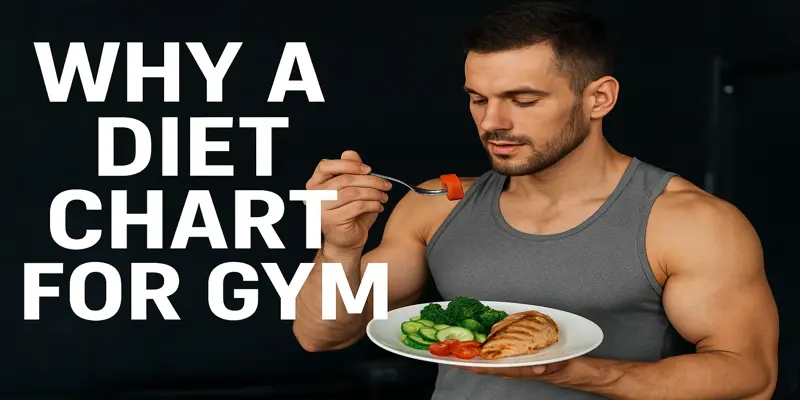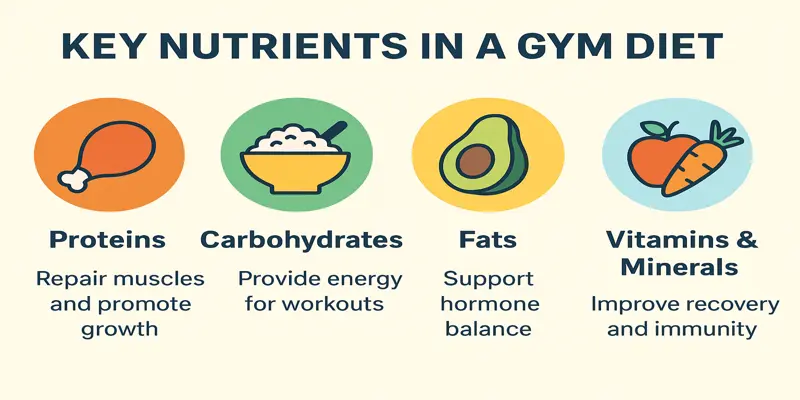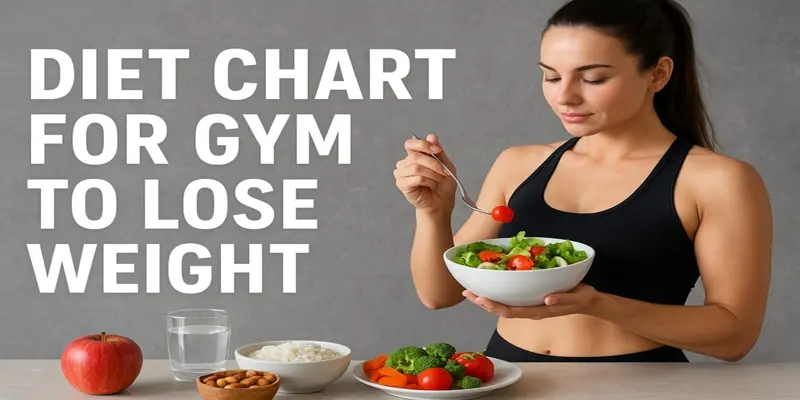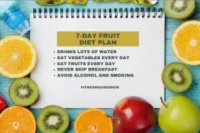Diet Chart for Gym | Simple & Effective Plan
Published: 29 August 2025
Diet Chart for Gym the secret behind visible results. No matter how hard you train, without the right food your muscles cannot grow and your body cannot recover. A balanced diet fuels every workout, builds lean muscle, and keeps your energy high throughout the day.
The right combination of proteins, carbs, and healthy fats ensures your body gets what it needs for strength and endurance. Whether you want to gain muscle or burn fat, a gym diet chart provides the structure to reach your goals faster. Consistency in both exercise and nutrition is the real key to success.
Following a simple yet effective gym diet can transform your body and improve performance in every session.
Table of Contents
Why a Diet Chart for Gym is Important

A gym workout alone cannot give the best results without proper food. A diet chart for gym provides the right balance of proteins, carbs, fats, vitamins, and water. This balance helps the body recover faster, build muscle, and maintain energy during training.
When you follow a clear diet chart, your meals support your fitness goal, whether it is weight loss, strength gain, or muscle building. A planned diet prevents weakness, keeps metabolism active, and improves overall performance in the gym.
Key Nutrients in a Gym Diet

A good gym diet is not only about eating more food, it is about eating the right nutrients in the right balance. These nutrients give energy for workouts, repair the body, and help build strength.
1. Protein – The Muscle Builder
Protein is the most important nutrient for gym lovers. It repairs damaged muscle fibers and supports growth after training. Good sources include eggs, chicken, fish, beans, and cottage cheese.
2. Carbohydrates – The Energy Fuel
Carbs give the energy needed for lifting weights and doing cardio. Complex carbs like brown rice, oats, and sweet potatoes release energy slowly, keeping you active during workouts.
3. Healthy Fats – The Support System
Fats are not always bad. Healthy fats keep hormones balanced and provide long-lasting energy. Nuts, seeds, avocado, and olive oil are great options.
4. Vitamins & Minerals – The Protectors
These keep the body strong from the inside. Vitamins and minerals improve recovery, protect against tiredness, and boost immunity. Vegetables and fresh fruits are the best sources.
5. Water – The Hidden Power
Hydration is often ignored, but it is the key to performance. Drinking enough water prevents cramps, keeps energy levels high, and supports muscle recovery.
Note: A balanced gym diet must include all these nutrients in the right amount. When combined with proper training, they help in building muscle, reducing fat, and improving overall fitness.
Diet Chart for Gym – Sample Plan
Here’s a balanced gym diet plan that suits most fitness goals:
| Time | Meal |
|---|---|
| Morning | Warm water with lemon + 5 soaked almonds |
| Breakfast | 4 boiled egg whites + 1 whole egg, 1 cup oats with milk, 1 banana |
| Mid-Morning | Whey protein shake + 1 apple or orange |
| Lunch | Grilled chicken breast / paneer, 1 cup brown rice or 2 chapati, salad |
| Evening Snack | Green tea / black coffee + roasted chickpeas or peanuts |
| Pre-Workout | 1 boiled sweet potato + 1 slice whole wheat bread with peanut butter |
| Post-Workout | Protein shake with water + 2 dates or 1 banana |
| Dinner | Grilled fish / chicken / paneer + steamed vegetables + quinoa |
| Bedtime | 1 glass warm milk or casein protein |
Diet Chart for Gym to Lose Weight

Losing weight is not only about exercising daily it is also about following the right diet. A proper diet chart for gym to lose weight helps you burn fat, improve stamina, and stay healthy without feeling weak. When you fuel your body with balanced meals, you get better results from your workouts.
Important Tips for Following a Gym Diet
- Start Your Day with a Healthy Meal
- Never skip breakfast. A balanced morning meal keeps your energy steady and prepares your body for workouts.
- Eat Small, Frequent Meals
- Divide your food into 5–6 portions instead of 2–3 heavy meals. This helps in better digestion and stable energy levels.
- Stay Hydrated
- Drink at least 3 liters of water daily. Proper hydration improves performance and prevents muscle cramps.
- Balance Protein, Carbs, and Fats
- Don’t depend only on protein. A healthy gym diet includes complex carbs for energy and good fats for hormone support.
- Choose Natural Foods Over Junk
- Stick to whole grains, fresh fruits, vegetables, and lean proteins. Avoid processed snacks and sugary drinks.
- Plan Meals Around Workouts
- Eat light, energy-rich food before training and have protein with quick carbs after workouts for recovery.
- Get Enough Sleep
- Recovery is not just about food. At least 7–8 hours of sleep helps muscles repair and grow stronger.
Common Mistakes to Avoid in a Gym Diet
Many people spend hours in the gym but fail to see results because their diet is not balanced. Below are the most common mistakes you should avoid:
1. Skipping Meals
Missing meals slows down metabolism and reduces energy for workouts. Always eat at regular intervals to keep your body fueled.
2. Eating Too Much Protein
Protein is important, but taking it in excess while ignoring carbs and healthy fats creates imbalance. Your body needs all nutrients in the right ratio.
3. Depending Only on Supplements
Supplements like whey protein help, but they cannot replace natural foods. Focus on whole foods first and use supplements only as support.
4. Low Water Intake
Dehydration reduces stamina, strength, and recovery. Drink at least 3–4 liters of water daily to stay active.
5. Overeating Junk Food
Fast food, sugary drinks, and fried snacks cancel out gym efforts. Stick to clean, home cooked meals for the best results.
6. Wrong Meal Timing
Eating heavy meals right before workouts or skipping post-workout nutrition affects performance. Always plan meals around training for better recovery.
7. Ignoring Vegetables and Fruits
Many focus only on protein but forget vitamins and minerals. Vegetables and fruits boost immunity, digestion, and recovery.
Conclusion
A balanced diet chart for gym is the real fuel behind strength, muscle growth, and fat loss. Training alone cannot deliver results unless it is supported with the right nutrition at the right time. Eating protein-rich foods, clean carbs, and healthy fats while staying hydrated ensures steady progress.
By following a structured gym diet plan, you can recover faster, perform better, and achieve your fitness goals with consistency. Focus on natural foods, proper meal timing, and discipline this combination will keep your body active, strong, and ready for every workout.

- Be Respectful
- Stay Relevant
- Stay Positive
- True Feedback
- Encourage Discussion
- Avoid Spamming
- No Fake News
- Don't Copy-Paste
- No Personal Attacks

- Be Respectful
- Stay Relevant
- Stay Positive
- True Feedback
- Encourage Discussion
- Avoid Spamming
- No Fake News
- Don't Copy-Paste
- No Personal Attacks





